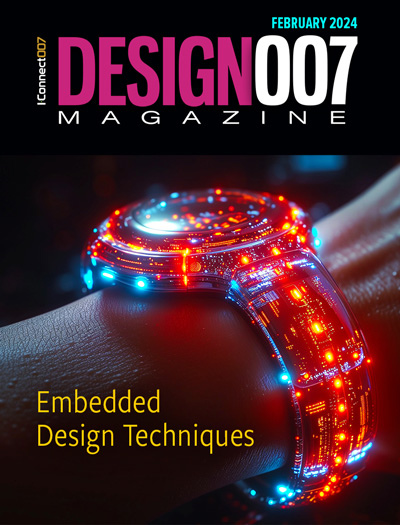-

- News
- Books
Featured Books
- design007 Magazine
Latest Issues
Current Issue
Level Up Your Design Skills
This month, our contributors discuss the PCB design classes available at IPC APEX EXPO 2024. As they explain, these courses cover everything from the basics of design through avoiding over-constraining high-speed boards, and so much more!

Opportunities and Challenges
In this issue, our expert contributors discuss the many opportunities and challenges in the PCB design community, and what can be done to grow the numbers of PCB designers—and design instructors.

Embedded Design Techniques
Our expert contributors provide the knowledge this month that designers need to be aware of to make intelligent, educated decisions about embedded design. Many design and manufacturing hurdles can trip up designers who are new to this technology.
- Articles
- Columns
Search Console
- Links
- Events
||| MENU - design007 Magazine
The Key to Eliminating Bad Design Data: Constant Vigilance
March 9, 2021 | I-Connect007 Editorial TeamEstimated reading time: 2 minutes
The I-Connect007 editorial team recently met with Jen Kolar and Mark Thompson of Monsoon Solutions to discuss ways to eliminate bad data from the design process, whether that be from CAD libraries, parts vendors, chip makers, or customers themselves. They key in on some problems and obstacles that allow incorrect data into the design cycle, and then highlight possible solutions.
Barry Matties: There are just so many places where you can introduce bad data into the design cycle. And as you both know, one of the biggest challenges is to get the data that you really need to be accurate right from the start. And, if it’s wrong at the beginning, it’s wrong all the way through.
Jen Kolar: It’s like any additive process, where the errors are added along the way. You have garbage in, garbage out in each step along the way. Maybe you have a thoughtful front-end designer who does a thoughtful design and gives really good input, but you have a PCB designer who’s sloppy and leaves half the detail out of the fab notes. Maybe it was good data into them, but they didn’t translate all that to the fab shop. Or maybe they had good data from one point, but you have those additive errors. Maybe there was a partial error at the beginning, but it just builds and builds, and gets worse and worse.
Matties: The thing is, if it’s good at one point, you have so many different points where it can go off the rails. It could be a combination of good data here, bad data there.
Kolar: I couldn’t agree more, and I think part of it is dependent on who’s driving the schedule in a project; a lot of times, the people driving the schedule just care that it’s started. You have management saying “Start,” so whoever is designing the project is saying, “Okay. I’m still figuring out my electrical design, but I’ve been told to put it in schematic.” You can end up with a project that takes a lot longer, costs more, and works poorer than if you’d just waited and started two months later.
Matties: And you’ll probably be doing multiple re-spins on it as well.
Kolar: Exactly. There are a lot of different sources of poor data: There’s just lack of knowledge, schedule pressure, sloppiness, and there is misinformation. There have been a number of times that we have engineers send us reference designs and say, “Just do what the reference design says.” Then we get to argue that the reference designs have nothing to do with manufacturability, and you repeat that cycle over and over. From our perspective, when you’re getting input data, ideally, you’re getting enough variants of it that you have something to validate against. Maybe I get a board file that has some of the parts loaded. Then, maybe I also have a STEP file or mechanical data that I can sanity-check against that, or the schematic, which is also going to have some callouts.
To read this entire interview, which appeared in the March 2021 issue of Design007 Magazine, click here.
Suggested Items
Siemens’ Breakthrough Veloce CS Transforms Emulation and Prototyping with Three Novel Products
04/24/2024 | Siemens Digital Industries SoftwareSiemens Digital Industries Software launched the Veloce™ CS hardware-assisted verification and validation system. In a first for the EDA (Electronic Design Automation) industry, Veloce CS incorporates hardware emulation, enterprise prototyping and software prototyping and is built on two highly advanced integrated circuits (ICs) – Siemens’ new, purpose-built Crystal accelerator chip for emulation and the AMD Versal™ Premium VP1902 FPGA adaptive SoC (System-on-a-chip) for enterprise and software prototyping.
Elevating PCB Design Engineering With IPC Programs
04/24/2024 | Cory Blaylock, IPCIn a monumental stride for the electronics manufacturing industry, IPC has successfully championed the recognition of the PCB Design Engineer as an official occupation by the U.S. Department of Labor (DOL). This pivotal achievement not only underscores the critical role of PCB design engineers within the technology landscape, but also marks the beginning of a transformative journey toward nurturing a robust, skilled workforce ready to propel our industry into the future.
IPC Design Competition Champion Crowned at IPC APEX EXPO 2024
04/24/2024 | IPCAt IPC APEX EXPO 2024 in Anaheim, California, five competitors squared off to determine who was the best of the best at PCB design.
Altus Group Helps BitBox Unlock Productivity and Efficiency Gains with New Reflow Oven
04/22/2024 | Altus GroupAltus Group, a leading provider of capital equipment, has recently assisted BitBox, a UK-based electronics design, engineering and manufacturing company in upgrading its operations with the implementation of a new reflow oven from Heller Industries.
Real Time with... IPC APEX EXPO 2024: Exploring IPC's PCB Design Courses with Kris Moyer
04/18/2024 | Real Time with...IPC APEX EXPOGuest Editor Kelly Dack and IPC instructor Kris Moyer discuss IPC's PCB design training and education offerings. They delve into course topics such as design fundamentals, mil/aero, rigid-flex, RF design, and advanced design concepts. They also highlight material selection for high-speed design, thermal management, and dissipation techniques. The interview wraps up with details about how to access these courses online.


